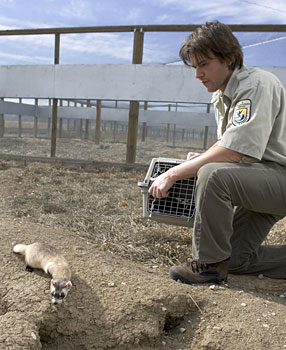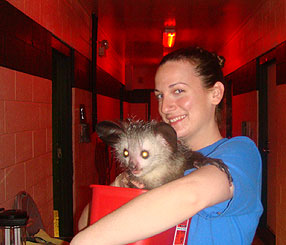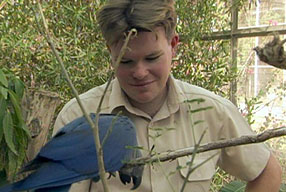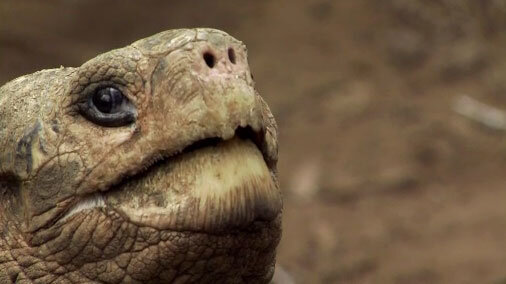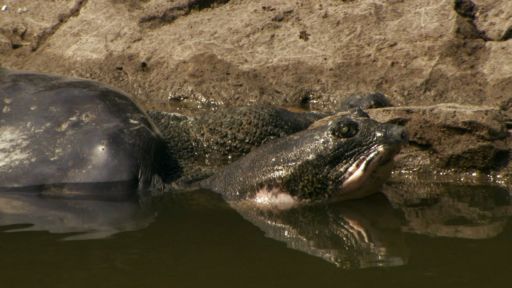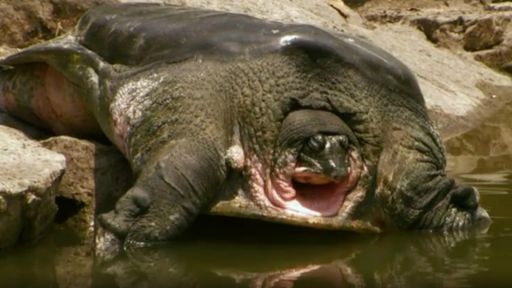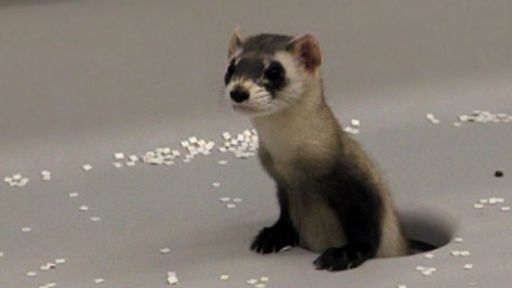PAUL MARINARI, U.S. Fish and Wildlife Service
Paul Marinari has been the on-site facility manager of the U.S. Fish and Wildlife Service’s Black-Footed Ferret Conservation Center in northern Colorado since 1996, but his focus on animals and commitment to conservation goes back much farther. “I pretty much knew that I wanted to be a biologist when I was in 5th or 6th grade after a report I did on sea slugs,” Marinari says. “As a kid, I was always identifying birds at the bird feeder in the back yard, incubating and hatching quail eggs then releasing them in the wild, going to nature centers.” His interest in animals and science, along with childhood trips to zoos and wildlife parks, “pretty much sealed the deal on my desire to concentrate on biology and anthropology while in college.” After finishing his undergraduate degree, Marinari went to the University of Wyoming for an M.S. in Zoology and Physiology.
Marinari says that his arrival to UW in 1989 was a case of being at the right place at the right time. “Plans to reintroduce ferrets were already well underway” and Marinari was able to work on a black-footed ferret project as he pursued his masters degree. He also worked with other endangered species like marble murrelets and spotted owls, gaining the experience that would eventually help him land the position of on-site facility manager at the Black-Footed Ferret Conservation Center.
A normal workday for Marinari differs depending on the time of year. “Breeding season goes from about January to June, with most of the kits born in May. We then have to make sure the kits survive and that our management doesn’t have a negative impact on overall productivity and survival.” In the fall, each kit has to be prepared for reintroduction by being placed in the outdoor preconditioning pen. Here they learn basic survival skills like how to hunt. At the same time the kits are being trained, Marinari has to start preparing for the next breeding season. It’s a position that is both challenging and rewarding, Marinari says. With the largest captive colony of black-footed ferrets in the world, the Center is responsible for the breeding, safety, and health of 65 to 70 percent of the captive species. The pressure of “knowing that a large part of the international program depends on good kit production numbers at the Center” is a constant in Marinari’s work.
However stressful his job may get, Marinari is grateful for his opportunity to be involved in Black-Footed ferret conservation. “Every day the animals will find some new way to surprise you.” For Marinari, it is a huge reward to know that “all the folks that are working on ferret recovery are making a difference in the world.” His experience has led him to believe that “no matter what folks decide they want to do with their lives, they should find something their passionate about and go for it! Everyone can truly make a difference in shaping the world we live in and the world we leave behind for future generations.” “See what’s going on in [your] own neighborhood.” Marinari says, “and make a positive difference locally.”
SAMANTHA TRULL, Duke Lemur Center
As a Primate Technician at the Duke Lemur Center, Sam Trull gets to observe, care for, and interact with prosimians all day. Like many others working in wildlife conservation, she has always known that she wanted to work with animals. “I originally wanted to become a veterinarian,” Sam says, “but as I grew older I became more interested in wildlife conservation than veterinary medicine.” She started volunteering at the Duke Lemur Center the summer after her sophomore year of high school, 12 years ago. Getting involved at a young age helped guide her academic path. She earned her B.S. in Zoology at North Carolina State University in 2003, and her M.S. in Primate Conservation at Oxford Brookes University in Oxford England in 2006, all while continuing to work at the Lemur Center. She plans to spend the rest of her life working with primates. “To hear a group of ringtailed lemurs vocalizing, hand a slow loris a worm, or weigh a baby aye-aye is an amazingly fulfilling experience,” Sam says. “I would do anything to make their lives a little better, and I will continue to dedicate my life to the conservation and welfare of lemurs, other primates, and all animals.”
Sam cares for many different species, but her favorite species is the aye-aye (Daubentonia madagascariensis). Sam loves “their curious nature, amazing morphological adaptations and the challenge that they present as a species to take care of in captivity.” Native to Madagascar, aye-ayes are currently critically endangered. They are also considered by many primatologists to be “the most unique primate in the world.” It is Sam’s job to make sure they don’t get bored. “Aye-ayes investigate everything, and because of their continuously growing incisors and extraordinary foraging technique, they require constant environmental enrichment!” This means Sam has to gather huge fallen logs (7-8 feet long and 10 inches in diameter) in the North Carolina forest surrounding the Center, and maneuver the logs into the aye-aye habitats. She places the logs diagonally—as “this more closely resembles how the trees would fall in the wild”—and lets the aye-ayes go wild. “The aye-ayes will spend hours investigating and chewing off pieces of the log looking for cavities where larvae and other insects may reside.”
A typical workday at the Center starts with preparing meals for all the animals in her care for the day. The rest of the day is split up between feeding, cleaning habitats, and special projects like aye-aye enrichment. “Every day is slightly different and sometimes I have to weigh infants, or help with the treatments of a sick or injured animal.”
RYAN WATSON, Al Wabra Wildlife Preservation
“For me, what I do for a living is more than just a job, it is my lifestyle,” says Ryan Watson, the Blue Macaw Coordinator at Al Wabra Wildlife Preservation in Doha, Qatar. Watson lives on-site at Al Wabra, where he works six days a week managing private captive breeding programs for several macaw species. But for Watson, the personal and professional are intertwined even beyond his living where he works: he met his wife through the Lear’s Macaw Recovery Project, which they are both involved with. A field biologist, she also lives and works at Al Wabra. “A lot of our time outside of work is spent discussing our future plans to continue conservation and research work with blue macaws,” he says.
For someone whose career and home life are so interconnected, it’s not surprising that Watson’s passion for his work is deep-seated. “My interest in wildlife conservation first began approximately 25 years ago when I watched a 60 Minutes story about the African rhino poaching crisis,” he says. The senseless killing of the animals for their horns left a strong impression on him, and he remembers “wishing that there was something I could do to help save them.”
Though Watson became interested in animal conservation early on, he also recounts the particular incident that inspired him to work with birds specifically. As a young boy in Australia, Watson had the experience of having a captive red-tailed black cockatoo fly to his arm and sit on his shoulder. “At first I was quite terrified that such a large bird with a powerful beak might inflict some damage, but … I let the gentle creature fly to me and walk up to my shoulder. That experience is what really ignited my passion for birds and is one I will most probably never forget,” he says.
Throughout his childhood, Watson kept and bred various bird species. Later, he went on to work at hand-rearing facility called Birdworld, and then became a bird-keeper at the Adelaide Zoo in western Australia. From there, he went on to work for several other organizations including the Keauhou Bird Breeding Center in Hawaii, and earned a postgraduate degree in ornithology from Charles Sturt University in Australia. Watson’s path to his current position at Al Wabra took him across the globe, where he worked with various species of birds and gained experience in conservation efforts. It was while he was working for the Echo parakeet recovery program in Mauritius that the position of Blue Macaw Coordinator for Al Wabra Wildlife Preservation was advertised globally. “I had long wanted to be involved with recovery efforts for the Spix’s macaw, a species who’s tragic story I had been following since the 1990’s, so I applied for the position and thankfully was offered the job.”
In the course of his career, Watson has learned that law and legislative policy are as important as the hands-on work he does directly in animal conservation. “The most important changes need to occur at policy level,” he says, “so during an election, choose to vote for a candidate who takes environmental issues seriously.”
At Al Wabra, part of Watson’s job is ensuring that he “make[s] the best possible pairing recommendations and decisions which are likely to lead to breeding success.” It’s no simple task, but Watson faces the job’s challenge with a wealth of passion and experience.

